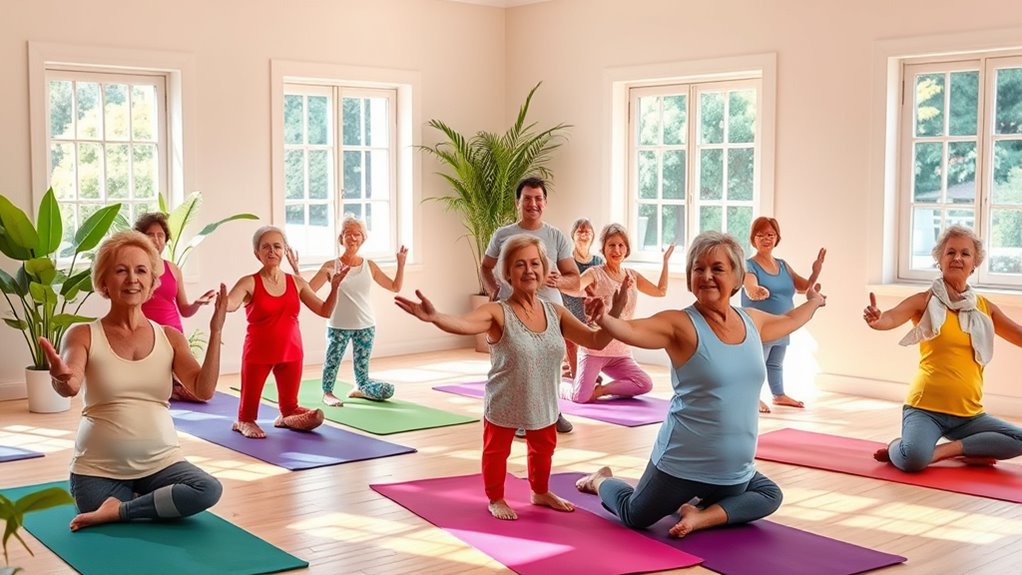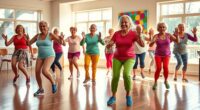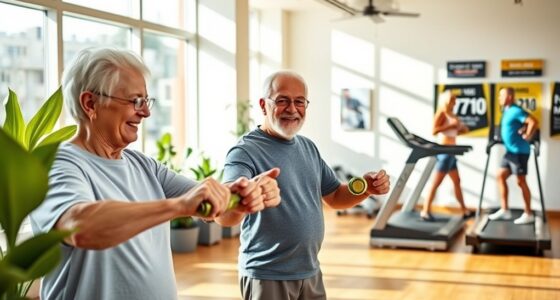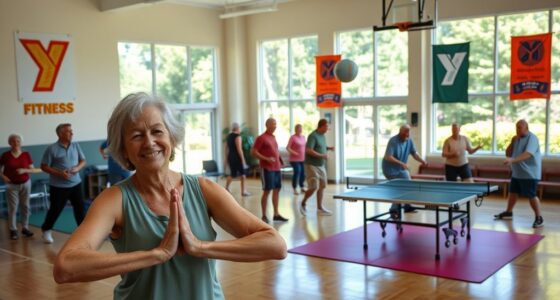Senior yoga classes can greatly boost your flexibility and peace of mind through gentle movements and mindful practices. By joining classes focused on restorative styles, you’ll enhance your balance and reduce stiffness in your joints. Using props for support while practicing breathing techniques helps promote relaxation and awareness. Incorporating these elements creates a calming experience that nurtures both body and mind. Explore more techniques that can enrich your yoga journey and overall well-being.
Key Takeaways
- Look for gentle or restorative yoga classes designed specifically for seniors to enhance flexibility and promote relaxation.
- Choose experienced instructors who can provide modifications tailored to seniors’ mobility and comfort levels.
- Incorporate props like blankets and blocks to improve stability and deepen stretches safely during practice.
- Practice mindfulness techniques and breathing exercises, such as diaphragmatic breathing, to reduce stress and enhance mental clarity.
- Engage in regular yoga sessions to foster physical well-being, improve balance, and cultivate a sense of peace.
Benefits of Yoga for Seniors

Yoga offers numerous benefits for seniors, especially when it comes to enhancing physical and mental well-being. Regular practice can greatly improve flexibility, helping you move more freely and reducing stiffness in your joints. You’ll find that improved balance and coordination can also lower your risk of falls, allowing you to maintain your independence. Plus, as you engage in mindfulness and breathing techniques on your yoga mat, you can decrease symptoms of anxiety and depression, boosting your mood and cognitive function. Research has shown that mindfulness practices can significantly enhance emotional well-being and reduce stress levels in seniors. Additionally, incorporating spiritual practices like meditation into your routine can further foster a sense of peace and connection. Many seniors are also discovering the benefits of spiritual retreats, which can provide a deeper level of healing and rejuvenation. Furthermore, studies suggest that listening to classical music during yoga sessions can enhance focus and relaxation, further enriching the experience. It’s important to remember that open communication with your body during each session is essential for preventing injury and alleviating discomfort in areas like your lower back.
Finding the Right Yoga Class

When you’re looking for the right senior yoga class, consider styles marked as “gentle” or “restorative” to match your flexibility needs. It’s also essential to check the instructor’s experience with seniors, as they can offer modifications tailored to your abilities. Finding a class that prioritizes both comfort and expertise can make all the difference in your yoga journey. Additionally, engaging in activities like yoga can enhance emotional well-being, similar to how pet therapy benefits dementia and Parkinson’s patients. Furthermore, consulting with a financial advisor can help ensure you manage any related health and wellness expenses effectively. Incorporating regular physical activity, such as yoga, is crucial for maintaining a healthy weight and overall wellness in seniors. Practicing yoga in a decluttered space can further enhance your experience, promoting mental clarity and tranquility. Creating a serene environment can also contribute to a better senior living experience, allowing you to fully immerse yourself in your practice.
Class Style Considerations
Finding the right yoga class for seniors involves considering styles that prioritize gentle movements and relaxation. Look for classes like Hatha or Restorative yoga, where every step is designed to promote ease and comfort. These classes often incorporate props like blankets and towels, helping you support your back and enhance your experience. A manageable class duration of around 60 minutes keeps fatigue at bay, allowing you to fully enjoy each session. Additionally, practicing yoga regularly can improve your overall well-being, which enhances overall well-being.
Incorporating practices like Yin yoga can further enhance relaxation and flexibility. It’s also essential to choose a supportive environment that encourages personal intention setting and mindfulness. This approach not only helps you feel comfortable but also allows you to come back feeling rejuvenated and at peace. Additionally, engaging in yoga can contribute to mental clarity and health, which enhances overall well-being. Practicing yoga regularly may also help mitigate symptoms of emotional dysregulation associated with mental health conditions, further promoting a balanced lifestyle. Yoga practices can also be tailored to enhance life at home, making it easier for seniors to incorporate wellness into their daily routine. Prioritize your well-being by selecting the right class style for your needs.
Instructor Experience Matters
Selecting the right class style is just the beginning; the instructor’s experience plays a significant role in your yoga journey. An experienced instructor is essential for senior yoga classes, as they can tailor sessions to meet various mobility levels and physical limitations. Look for instructors trained in gentle or restorative yoga, as they’re better equipped to guide you through poses that enhance flexibility while ensuring safety. Knowledgeable instructors will use props like blocks and straps to help achieve correct alignment and maximize comfort. Additionally, protecting energy during yoga practice is vital for overall well-being. Incorporating personalized learning pathways into your yoga sessions can further enhance your experience by catering to your specific needs and goals.
Classes led by seasoned instructors often emphasize breath work and mindfulness, boosting your mental well-being. Moreover, instructors with experience in newborn feeding options can draw parallels to the importance of understanding individual needs, fostering a supportive environment that encourages relaxation and community building. Incorporating growth mindset principles in your practice can also empower you to embrace challenges with confidence. Finally, choosing an instructor with experience working with older adults fosters a supportive environment that encourages relaxation and community building. Additionally, an experienced instructor can help cultivate creative practice, allowing seniors to explore new forms of movement and expression.
Essential Yoga Props for Comfort and Support

Using yoga props can make your practice more enjoyable and accessible. Essential items like blankets, blocks, and straps provide support and comfort, ensuring you can safely explore each pose. Let’s look at some suggested props that can enhance your experience and help you adapt to your needs. Incorporating interactive learning toys can similarly support cognitive and physical development in children, promoting overall growth and skill acquisition. Additionally, practicing yoga outdoors in natural settings can enhance relaxation and mindfulness, creating a more peaceful environment for your sessions. Utilizing props can also aid seniors in maintaining digital literacy skills as they learn to engage with technology safely. Moreover, incorporating natural remedies like yoga can improve overall well-being and reduce stress levels.
Importance of Props
Props play an essential role in enhancing your yoga practice, especially for seniors. They provide vital support and comfort, making poses more accessible whether you’re a senior or a beginner.
By using props, you can improve stability and alignment, reducing injury risk while creating a safer practice environment. Props also facilitate deeper stretches and greater relaxation, allowing you to explore your range of motion without strain.
Incorporating these tools encourages creativity in your home practice, enabling you to tailor your routine to your specific needs and comfort levels.
Ultimately, props foster a sense of ease and confidence, empowering you to focus on your breath and body awareness during your yoga sessions, enhancing your overall experience.
Suggested Prop Types
When considering your yoga practice, incorporating essential props can greatly enhance your comfort and support.
Yoga blocks are fantastic for providing stability and balance in various poses. A sturdy strap helps you achieve deeper stretches, allowing you to maintain flexibility without straining your muscles.
Blankets or towels offer extra cushioning, making poses more accessible, especially if you have limited mobility. A bolster acts as a supportive cushion, particularly in restorative poses, encouraging relaxation and ease.
Finally, a chair is a versatile prop that allows you to perform seated poses safely, boosting your confidence and stability.
Breathing Techniques for Relaxation

Breathing techniques play an essential role in enhancing relaxation during yoga, especially for seniors seeking to reduce stress. By practicing diaphragmatic breathing, you activate your parasympathetic nervous system, promoting calmness.
Try taking slow, deep breaths—inhale for a count of four and exhale for a count of six. This not only increases lung capacity but also improves your overall respiratory function. Incorporating breath awareness during your sessions fosters mindfulness and helps you connect with your body and emotions.
You might also explore “4-7-8 breathing,” inhaling for four seconds, holding for seven, and exhaling for eight. This technique can greatly lower your heart rate and enhance relaxation, making your yoga practice more centered and balanced.
Gentle Movements for Flexibility

Gentle movements in yoga are essential for enhancing flexibility, especially for seniors looking to improve their range of motion. Incorporating seated twists and arm reaches can promote spinal mobility, making them perfect for your practice.
Using props like blankets or towels can provide extra support, helping you feel more comfortable and encouraging deeper stretches. As you synchronize your breath with each movement, you’ll reduce tension and allow your body to relax into poses.
Standing poses, like Triangle Pose and Wide-Legged Forward Fold, not only strengthen your body but also improve flexibility through proper alignment.
Regularly practicing these gentle movements increases your body awareness, preventing injuries and enhancing your daily functional movements. Embrace the journey to greater flexibility!
Incorporating Twists for Spinal Health

Incorporating twists into your yoga practice can greatly enhance spinal health, especially for seniors seeking improved mobility. Seated twists promote spinal flexibility, making everyday movements easier and more comfortable.
Plus, these twists encourage deep breathing, improving lung capacity and oxygen flow, which contributes to your overall well-being and relaxation. Regular practice of gentle twists can alleviate tension in your back and neck, enhancing posture and reducing discomfort.
Engaging your core muscles during these poses is essential for maintaining balance and stability, particularly as you age. Additionally, gentle twists stimulate digestion and promote detoxification, supporting your health and wellness.
Standing Poses to Enhance Stability

While you may not realize it, standing poses play an important role in enhancing your stability and balance. Poses like Triangle Pose and Mountain Pose promote proper alignment and grounding through all four corners of your feet.
Engaging in these poses activates your core muscles, improving balance and body awareness—essential for preventing falls as you age. Incorporating deep, synchronized breathing fosters a sense of calm and strengthens the mind-body connection.
Wide-legged poses, such as the Standing Wide-Legged Forward Fold, enhance flexibility in your hips and lower back, necessary for maintaining mobility.
Mindfulness and Meditation Practices

Mindfulness and meditation practices can transform your daily routine, bringing considerable benefits to your overall well-being. By regularly engaging in these practices, you can considerably reduce stress and anxiety, fostering a sense of peace.
Improved cognitive function and better memory retention are additional perks, making mindfulness especially beneficial as you age. These practices also enhance emotional regulation, allowing you to manage your emotions effectively and maintain a positive outlook.
Plus, mindfulness can increase feelings of social connectedness, combating loneliness that many seniors experience. Practicing mindfulness encourages greater body awareness and keeps you present in the moment, which can boost both your physical flexibility and mental clarity.
Embrace these techniques to enrich your life!
Creating a Home Yoga Routine

Practicing mindfulness can set a strong foundation for creating a home yoga routine that enhances your overall well-being.
Start by designating a quiet, comfortable space free from distractions. This calming environment will help you focus and relax. Incorporate props like blankets or cushions to support your poses, making them more accessible.
Design a serene space free from distractions, using props for comfort to enhance your focus and relaxation during yoga practice.
Begin each session with mindful breathing and intention-setting to foster a positive mindset. Include gentle movements, stretches, and standing poses to gradually improve your flexibility and strength while ensuring safety.
Ultimately, aim for consistency by dedicating specific times each week for your practice. This routine not only promotes long-term well-being but also contributes to your peace of mind.
Enjoy the journey and listen to your body!
Frequently Asked Questions
Which Type of Yoga Is Best for Seniors?
If you’re wondering which type of yoga is best for seniors, consider gentle forms like Hatha or restorative yoga.
These styles focus on relaxation, balance, and safety, making them accessible for everyone.
You might also enjoy chair yoga, which allows you to practice while seated, ensuring stability.
Iyengar yoga can help you improve alignment and flexibility with the use of props.
Choose what feels right for you, and enjoy the benefits of each style!
Is 70 Too Old to Start Yoga?
No, 70 isn’t too old to start yoga!
In fact, many people begin their yoga journey later in life and find it incredibly rewarding. You can enhance your flexibility, balance, and overall health at your own pace.
Yoga’s gentle movements adapt to your needs, making it safe and enjoyable. Plus, the focus on mindful breathing can bring a sense of calm and peace, enriching your mental well-being as you embrace this new practice.
How Many Times a Week Should Seniors Do Yoga?
Think of your body as a garden; nurturing it with yoga can help it bloom beautifully.
You should aim to practice yoga 2 to 3 times a week to enhance your flexibility and balance. If you feel up to it, increasing your sessions to 4 to 5 times weekly can lead to even more benefits.
Just remember to listen to your body and adjust your routine based on how you feel each day.
Which Is Better for Seniors, Pilates or Yoga?
When deciding between Pilates and yoga, it really depends on what you’re looking for.
If you want to enhance flexibility and find mental peace, yoga might be your best bet.
On the other hand, if you’re focused on building strength and improving posture, Pilates could be the way to go.
Many seniors benefit from incorporating both practices into their routine, so don’t hesitate to explore and see what feels right for you!
Conclusion
So, if you think yoga’s just for pretzel-bending youngsters, think again! Embracing senior yoga classes can transform your flexibility and peace of mind faster than you can say “downward dog.” You’ll be stretching, breathing, and finding your inner zen while your friends are still trying to figure out how to get off the couch. So why not swap the remote for a yoga mat? Your body and mind will thank you—plus, you’ll have a great story for the next bingo night!










